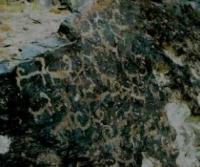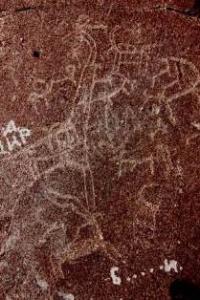Вы здесь
Petroglyphs of the Kazakhtau massif.



Rock carvings tours in Central Asia.
“Our whole history is a product of nature of that immense land that we inherited. It was she who scattered us in all directions and scattered in space from the first days of our existence. ”
Chaadaev P.Ya.
Rock paintings of Central Asia.
The group of petroglyphs at the Belkuduk well is located in a small hollow on the right side of the road, on the way from the Yarakuduk well towards Garashkuduk, the figures are knocked out on horizontal and inclined basalt planes.
Some images are made on vertical stone exits. Basically, these are rectilinear schematic images. Technique - spot. The patinization of the images is weak (dirty gray). Such a patina of figures in this situation does not mean relative youth, 11 images, but rather low light, since the hollow is surrounded by mountains and the direct sun only gets there at noon.
The number of petroglyphs here is quite significant. It can be assumed that there are at least half a thousand of them. Judging by the fact that almost all of them were executed in approximately the same artistic style, it is very interesting to work on this monument in the future to identify some local tradition, taking into account the proximity of the Neolithic monuments of the Lavanakan Lakes (Vinogradov and Mamedov, 1975).
Suffice it to say at least that, for example, the materials at the Belkuduk well are represented exclusively by rectilinear-schematic images. Such artistic stylistics, as a rule, is very difficult from the point of view of chronological assessment, since such images are found from ancient times to the present day.
The collection of cave paintings of Belkuduk suggests the possibility of dating this complex to the Saka or before the Saka time (Oskin, 1978, p. 167). It is possible that it is here, on the samples made in the utmost schematism, that we will be able to identify new semantic elements.
A little south in the same mountains in the valley of the Karakuduk well there are small groups of petroglyphs of 3 - 4 images and single figures. They beat out on basalts and shales. Most of them are apparently of a late order.
Basically, these are figures of one-humped camels, which are not found in early materials, horse figures and signs. Near the village of Ayakkuduk (Kazakhtau mountains), in a nameless valley near the Muslim cemetery, a granodiorite rock was discovered with rather late, apparently medieval figures (goats, a two-humped camel with a horseman).
Figures of animals, tamgas and solar signs are also recorded in the cemetery on grave posts. We did not have the opportunity to conduct a more thorough examination of the mountains surrounding the basin of the Llyvakan Lakes, but these rare finds and, especially, the finds of Belkuduk petroglyphs allow us to hope in the future for the discovery of new materials here.
In the southern part of Kyzylkum in the mountains of Kuldzhuktau, we found very few rock paintings. In the Taushan valley (the southern slopes of Kuldzhuktau), on the basalt outcrops of the right bank, a group of petroglyphs of rather primitive artistic performance was revealed, but gravitating towards more realistic traditions than conventional schematism, the figures are strongly patinated.
It is difficult to judge the time of such a small group, and yet according to the general nature of the images, one can assume their time by the level of Saks and earlier.
Authority:
Petroglyphs of the Central Kyzyl Kum as a historical source for the study of archaic cults. Oskin Alexander Vasilievich. Moscow, 1985.
Photos by
Alexander Petrov.







